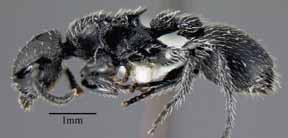

Formicidae, Hymenoptera, Insecta, Arthropoda, Animalia
|
|
|
Image catalogue, holotype worker (click here).
Range
Costa Rica.
Description of worker
Holotype worker measurements: HW 1.615, HL 1.462, SL 0.812, EL 0.365, MeL 1.821, MeW 1.165, PrW 0.812, PrL 0.552, PrS 0.236, PrT 0.787, MTL 1.015, PtL 0.555, PtW 0.457, PpW 0.592, PtH 0.452, AL 1.821, AW 1.510, ASW 0.041.
Similar to P. impressus, P. paleatus, and P. subpilosus; entire disc of the face with evenly dispersed erect setae; face sculpture, head shape, mesosomal profile, mesonotal teeth, propodeal suture, mesosomal sculpture, petiole shape and sculpture, and postpetiole shape and sculpture similar to P. paleatus; striae on the first gastral tergite fade out discally and posteriorly, similar to P. subpilosus; density of pilosity on gaster intermediate between P. impressus and P. paleatus, setae aligned on longitudinal axis subcontiguous, not or barely overlapping, but not as widely spaced as on P. paleatus.
Kempf (1951:53), identifying the series from Zent as P. paleatus, thoroughly described the worker.
Description of queen:
Measurements of paratype queen (LACM ENT 141766): HW 1.572, HL 1.469, SL 0.810, EL 0.375, MeL 1.958, MeW 1.239, MTL 1.041, MFL 1.092, MFW 0.383, PtL 0.613, PtW 0.429, PpW 0.575, PtH 0.455, AL 1.977, AW 1.560.
Shape, sculpture, and pilosity as in worker, except for mesosomal characters typical of caste; pronotum with coarse piligerous foveae, confluent laterally and posteriorly, smaller and separated by broad interspaces anteromedially; mesoscutum, axillae, and scutellum with mixture of longitudinal rugae and elongate piligerous foveae; dorsal face of propodeum with longitudinal, vermiculate rugae; wings smokey brown.
Natural History
The nest series from which the holotype was selected was collected from lowland rainforest. The nest was in a trailside woody plant stem whose apex was an old machete cut. The ants inhabited the dead terminus of the branch, just distal to the live portion. The live stem was solid, and the ants were in chambers excavated either by themselves or by a previous stem-boring insect. The entire nest was sampled, and contained 108 workers, one dealate queen, one alate queen, and brood. The other specimens from the type locality were collected from low vegetation. The worker from below Volc‡n Barba was collected from the canopy of primary rainforest, approximately 20m high.Workers from 17km S Puerto Viejo were in the crown of a recent treefall, in primary wet forest.
Types and Synonymy
Procryptocerus paleatus (part): Kempf, 1951:53-55, fig. 1, 20, 50, 67 (nec Emery) (description of worker: Costa Rica, Zent (Mann), misidentified as P. paleatus).
Procryptocerus tortuguero Longino and Snelling 2002:28. Holotype worker: Costa Rica, Prov. Limon, Tortuguero, 10ˇ32'N 83ˇ31'W, 5m, 1-5 Jul 1985 (Longino #382) [INBC]. Barcode: LACM ENT 141741.
Page author:
John T. Longino, The Evergreen State College, Olympia WA 98505 USA. longinoj@evergreen.edu
Date of this version: 6 December 2002.